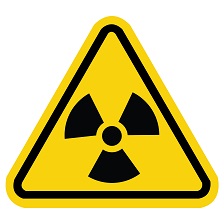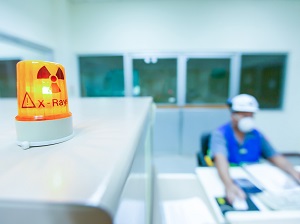Radiation sources are found in a wide range of occupational settings. While everyone is exposed to natural background radiation, workers may also be exposed to ionizing radiation in workplaces with radiation sources.
If radiation is not properly controlled, it can be potentially hazardous to the health of workers. This is why regulatory requirements are in place to ensure that this work can be done safely to minimize the risk to workers and those nearby.

The two types of ionizing radiation are:
- Particulate (alpha, beta, neutrons)
- Electromagnetic (x-rays, gamma rays)
Industrial radiography utilizes ionizing, electromagnetic radiation including x-rays and gamma sources (such as iridium-192, cobalt-60 and selenium-75). Certified personnel use high-activity sealed radioactive sources of ionizing radiation in certified exposure devices.
Industrial radiography, used in a variety of industries, is a non-destructive method of testing that uses ionizing radiation (x-rays or gamma rays) to inspect materials and components using an exposure device with the purpose of locating defects and degradation. Inspection techniques can be portable or stationary. Personnel using an exposure device must be trained and certified.
OSHA Standard 1910.1096 provides the requirements for ionizing radiation including exposure limits.
Occupational settings with ionizing radiation sources include:
- Medical and dental offices (e.g., X-rays).
- Hospitals and outpatient treatment centers, including specialty departments in:
- Radiology (e.g., medical X-rays and computed tomography (CT) scans).
- Nuclear medicine.
- Radiation oncology.
- Interventional fluoroscopy or radiology.
- Cardiac angiography.
- Nuclear power plants (reactors) and their support facilities.
- Nuclear weapons production facilities.
- Industrial operations (e.g., radiography equipment for testing materials or products).
- Research laboratories (universities, colleges, and other scientific institutions).
- Veterinary facilities.
- Manufacturing settings and construction.
- Security operations.
- Air and space travel and transport (i.e., in-flight) operations, especially at high altitude.
- Workplaces with high levels of naturally-occurring radioactive materials (NORM), such as radon.
- Worksites with high levels of technologically enhanced naturally-occurring radioactive material (TENORM), such as uranium and other radioactive elements encountered during hydraulic fracturing (commonly known as “fracking”) as part of oil and gas well development.
Developing and implementing a radiation protection program is a best practice for protecting workers from ionizing radiation. A radiation protection program is usually managed by a qualified expert who is acts as the radiation safety officer (RSO).
A radiation protection program should include, at a minimum:
- Qualified staff to provide oversight and responsibility for radiation protection policies and procedures.
- ALARA stands for As Low As Reasonably Achievable (ALARA). It is a guiding principle in radiation protection used to eliminate radiation doses that have no direct benefit.
- A dosimetry program in which personal exposure monitoring is conducted, as required by federal or state regulations, for external dose and, as needed, for internal dose.
- Surveys and area monitoring to document radiation levels, contamination with radioactive materials, and potential worker exposures.
- Radiological controls, including entry and exit controls, receiving, inventory control, storage, and disposal.
- Worker training on radiation protection, including health effects associated with ionizing radiation dose, and radiation protection procedures and controls to minimize dose and prevent contamination.
- Emergency procedures to identify and respond to radiological emergency situations.
- Recordkeeping and reporting programs to maintain all records and provide dosimetry reports and notifications, as required by federal or state regulations.
- Internal audit procedures to annually audit all aspects of the radiation protection program.
Another best practice is designating a radiation safety committee, which includes the RSO, a management representative, and workers who work with radiation-producing equipment, radiation sources, or radioactive materials (or who are otherwise at risk of exposure on the job).
Industrial radiographers have a responsibility to keep their workplace safe by following standard operating procedures and security requirements as outlined in the radiation protection program, which includes complying with all applicable regulatory requirements.
A key concept underlying radiation protection programs is keeping each worker's occupational radiation dose As Low As Reasonably Achievable (ALARA). An ALARA program usually involves maintaining radiation doses to workers as far below the federal and state regulatory occupational dose limits as is reasonably achievable taking into consideration the state of technology, economics, and social factors. ALARA in the workplace minimizes radiation doses and releases of radioactive materials using all reasonable methods available.

The principles of radiation protection include:
- Time. The shorter the time spent close to the source, the lower the radiation dose that will be received.
- Distance. The intensity of radiation falls off sharply as a person moves farther away from the radioactive source.
- Shielding. The thicker the protective material placed between the person and the source, the less the amount of radiation a person will receive.
When ionizing radiation interacts with humans, it is capable of damaging living cells in the human body. Workers can be exposed to radiation when they are
- in close proximity to an unshielded or partially shielded radiation source.
- unprotected when near unshielded radiation-generating machines in operation.
- unprotected when handling radioactive materials.
- in close proximity to surfaces or areas contaminated with radioactive materials.
- contaminated with radioactive materials.
Gamma rays and x-rays are very penetrating and can travel great distances. Lead or concrete is able to reduce the intensity of gamma rays and x-rays. Gamma rays and x-rays can easily pass completely through the human body but a fraction of the energy can be absorbed by tissue and can damage living cells.
Every employer shall supply appropriate personal monitoring equipment, such as film badges, pocket chambers, pocket dosimeters, or film rings, and shall require the use of such equipment by each employee who enters a restricted area under such circumstances that he receives, or is likely to receive, a dose in any calendar quarter in excess of 25 percent of the applicable occupational limit.
Radiation dose can be grouped into two categories based on the duration of exposure to the radiation source. Acute dose occurs in a matter of minutes, hours, or a few days. Chronic dose is continuous or intermittent exposure to radiation occurring over a long period of time.
The most common causes of industrial radiography incidents include:
- Failure To Follow Procedures
- Insufficient Training
- Inadequate Maintenance
- Equipment Malfunction
- Willful Violation
In many incidents reported, the radiographer did not use a survey meter to confirm that the source was shielded, and in some cases, the radiographer even switched off their person alarm, or just ignored the signal.
Safety measures required during radiography work may include:
- Cordoning the controlled area
- Placing warning signs or signals
- Clearing the controlled area
- Making audible and visual signals
- Patrolling the area and check radiation exposure levels
- Performing visual checks of cables, guide tubes and fittings
- Locking and safely storing exposure containers during meal breaks

Radiation-generating machines, such as medical X-ray machines, produce ionizing radiation electronically and stop producing radiation when turned off. Equipment that contains radioactive material, such as some industrial radiography equipment, cannot be turned off because the radioactive source emits ionizing radiation. These sources must be shielded (i.e., surrounded by a material that can block radiation) to prevent or reduce radiation exposure.
The radiation protection program should specifically address:
Training. Radiation sources and devices should only be assigned to and used by fully trained workers and periodic refresher training is recommended.
Engineering Controls. The need for shielding depends on the type and activity of the radiation source.
Administrative Controls. Examples include signage, warning systems, and written operating procedures to prevent, reduce, or eliminate radiation exposure. Operating procedures typically include both normal operating procedures and emergency procedures (spills, leaks, and emergency evacuation).
Personal Protective Equipment. PPE will not protect workers from direct, external radiation exposure unless the PPE contains shielding material. Examples of commonly used PPE for radiation protection from x-rays and gamma rays include lead aprons or vests, lead thyroid collars, lead gloves, and safety goggles.
Survey Instruments. Monitoring equipment to evaluate exposure rates, dose rates, and the quantities of radioactive materials and contamination includes handheld survey meters, radioisotope identification devices (RIID), and personal radiation detectors (PRD).
False Alarms. All alarms should be immediately reported to the radiation safety officer so they have the opportunity to investigate and solve. Do not ignore alarms!
Conflicting Warning Signals. Operators must be trained on how to react in the case of conflicting warning signals.
Spare Parts. Safety devices must be maintained, and spares of essential components should be readily available.

.jpeg)

.jpg)